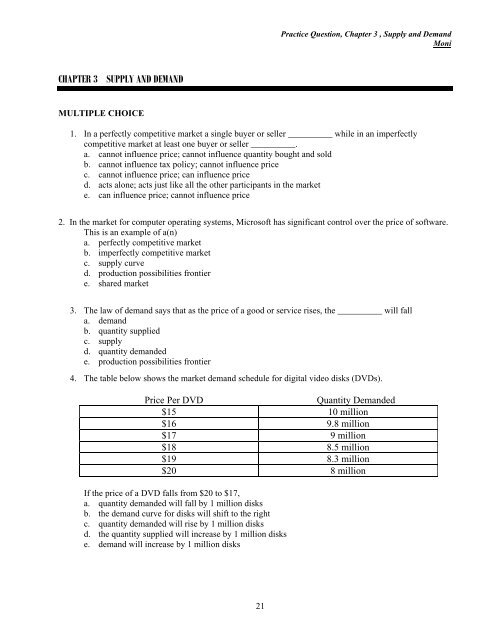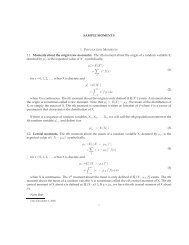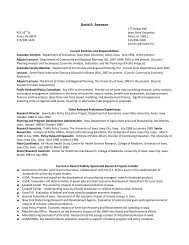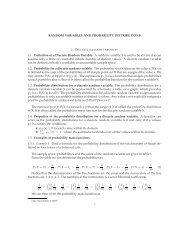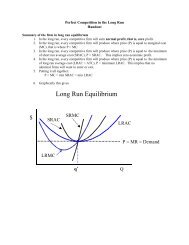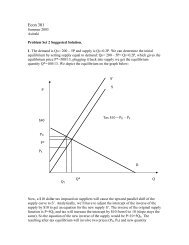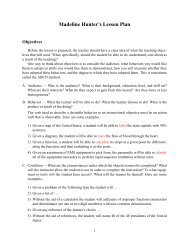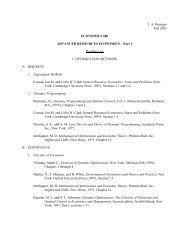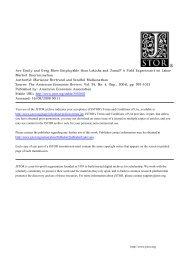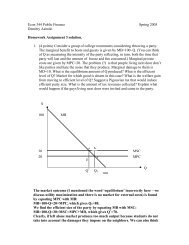Practice Questions for Chapter 3
Practice Questions for Chapter 3
Practice Questions for Chapter 3
You also want an ePaper? Increase the reach of your titles
YUMPU automatically turns print PDFs into web optimized ePapers that Google loves.
<strong>Practice</strong> Question, <strong>Chapter</strong> 3 , Supply and Demand<br />
Moni<br />
CHAPTER 3<br />
SUPPLY AND DEMAND<br />
MULTIPLE CHOICE<br />
1. In a perfectly competitive market a single buyer or seller __________ while in an imperfectly<br />
competitive market at least one buyer or seller __________.<br />
a. cannot influence price; cannot influence quantity bought and sold<br />
b. cannot influence tax policy; cannot influence price<br />
c. cannot influence price; can influence price<br />
d. acts alone; acts just like all the other participants in the market<br />
e. can influence price; cannot influence price<br />
2. In the market <strong>for</strong> computer operating systems, Microsoft has significant control over the price of software.<br />
This is an example of a(n)<br />
a. perfectly competitive market<br />
b. imperfectly competitive market<br />
c. supply curve<br />
d. production possibilities frontier<br />
e. shared market<br />
3. The law of demand says that as the price of a good or service rises, the __________ will fall<br />
a. demand<br />
b. quantity supplied<br />
c. supply<br />
d. quantity demanded<br />
e. production possibilities frontier<br />
4. The table below shows the market demand schedule <strong>for</strong> digital video disks (DVDs).<br />
Price Per DVD<br />
Quantity Demanded<br />
$15 10 million<br />
$16 9.8 million<br />
$17 9 million<br />
$18 8.5 million<br />
$19 8.3 million<br />
$20 8 million<br />
If the price of a DVD falls from $20 to $17,<br />
a. quantity demanded will fall by 1 million disks<br />
b. the demand curve <strong>for</strong> disks will shift to the right<br />
c. quantity demanded will rise by 1 million disks<br />
d. the quantity supplied will increase by 1 million disks<br />
e. demand will increase by 1 million disks<br />
21
<strong>Chapter</strong> 3 – Supply and Demand <strong>Practice</strong> Question<br />
5. A decrease in the price of a good results in a(n)<br />
a. increase in demand<br />
b. decrease in demand<br />
c. increase in quantity demanded<br />
d. decrease in quantity demanded<br />
e. decrease in supply<br />
6. Which of the following would cause the demand curve <strong>for</strong> handheld computers to shift to the right?<br />
a. an increase in the price of the labor used to manufacture the handhelds<br />
b. a decrease in the price of the handheld computers<br />
c. a decrease in the price of cell phones, a substitute <strong>for</strong> the handheld computers<br />
d. an increase in buyers’ incomes<br />
e. a decrease in the price of components used to manufacture handheld computers<br />
7. If he price of soft drink A increases, the demand <strong>for</strong> soft drink B will<br />
a. increase because the two goods are substitutes<br />
b. increase because the two goods are complements<br />
c. decrease because the two goods are complements<br />
d. decrease because the two goods are subsitutes<br />
e. not change, since the price of soft drink B did not change<br />
8. If bagels are a normal good and buyers’ incomes decrease, then<br />
a. the demand <strong>for</strong> bagels will increase<br />
b. the supply of bagels will increase<br />
c. the supply of bagels will decrease<br />
d. there is no relationship between income and demand<br />
e. the demand <strong>for</strong> bagels will decrease<br />
9. Apples and pears are often substitutes, there<strong>for</strong>e a increase in the price of apples will result in a(n)<br />
a. increase in the supply of apples<br />
b. decrease in the demand <strong>for</strong> apples<br />
c. decrease in the demand <strong>for</strong> pears<br />
d. increase in the demand <strong>for</strong> pears<br />
e. violation of the law of demand<br />
10. A good is said to be inferior if a(an)<br />
a. decrease in income leads to a decrease in the demand <strong>for</strong> the good<br />
b. increase in price lead to an increase in the demand <strong>for</strong> the good<br />
c. decrease in the price of substitute products leads to a decrease in the demand <strong>for</strong> the good<br />
d. increase in income leads to an increase in the demand <strong>for</strong> the good<br />
e. increase in income leads to a decrease in the demand <strong>for</strong> the good
<strong>Chapter</strong> 3 – Supply and Demand<br />
<strong>Practice</strong> Question<br />
11. In the above figure, which of the following would cause the demand curve <strong>for</strong> CDs to shift from D 0 to<br />
D 1 ?<br />
a. increased availability of free music over the Internet<br />
b. increased production costs <strong>for</strong> CDs<br />
c. decreased production costs <strong>for</strong> CDs<br />
d. the music industry announces that price hikes <strong>for</strong> CDs are coming in the next month<br />
e. decreased incomes of music buyers<br />
12. The fact that price and quantity supplied are positively related is an example of the<br />
a. law of demand<br />
b. law of opportunity cost<br />
c. law of supply<br />
d. law of quantity supplied<br />
e. law of algebra<br />
13. Which of the following would cause a decrease in quantity supplied rather than a decrease in supply?<br />
a. a decline in productive capacity<br />
b. an increase in input prices<br />
c. a decrease in the price of the good<br />
d. an increase in taxes<br />
e. the suppliers begin to expect the price to decrease in the near future<br />
14. Which of the following would cause a rightward shift of the supply curve <strong>for</strong> cell phones?<br />
a. a decrease in the price of a crucial component used in the production of cell phones<br />
b. an increase in the price of cell phone themselves<br />
c. an increase in the expected future price of cell phones<br />
d. a decrease in the number of companies selling cell phones<br />
e. a new tax on each cell phone produced
<strong>Chapter</strong> 3 – Supply and Demand <strong>Practice</strong> Question<br />
15. Which of the following could cause the movement from S 0 to S 1 shown in the above figure?<br />
a. a drop in population<br />
b. a decrease in the price of a complementary good<br />
c. a decrease in taxes<br />
d. an increase in input prices<br />
e. a shift of consumers’ tastes and preferencesaway from the product<br />
16. If the government offers a subsidy to the producers of a particular good,<br />
a. the demand <strong>for</strong> the product will increase<br />
b. the supply of the product will decrease<br />
c. the supply curve <strong>for</strong> the product will shift leftward<br />
d. the supply of the product will increase<br />
e. the demand <strong>for</strong> the product will decrease<br />
17. Equilibrium is defined as the point at which<br />
a. supply and demand are equal<br />
b. quantity supplied is greater than quantity demanded<br />
c. quantity demanded is greater than quantity supplied<br />
d. all scarcity has been eliminated<br />
e. there is no tendency <strong>for</strong> the price to change<br />
18. Supply and demand schedules <strong>for</strong> soda are given in the table below. What is the equilbrium price?<br />
a. $0.90<br />
b. $1.00<br />
c. $1.10<br />
d. $1.20<br />
e. $1.30<br />
Price Per Bottle Quantity Supplied Quantity Demanded<br />
$0.80 12 15<br />
$0.90 14 14<br />
$1.00 16 13<br />
$1.10 18 12<br />
$1.20 20 11
<strong>Chapter</strong> 3 – Supply and Demand<br />
<strong>Practice</strong> Question<br />
19. Suppose the market <strong>for</strong> watches is currently in equilibrium. Which of the following would cause the price<br />
of watches to fall while at the same time the quantity of watches bought and sold increases?<br />
a. an increase in the population of watch buyers<br />
b. an increase in the cost of an important input used to manufacture watches<br />
c. a decrease in the wages of the laborers who make the watches<br />
d. a decrease in the price of watch bands, a complement to watches<br />
e. a new tax is placed on watches<br />
20. Suppose the market <strong>for</strong> athletic shoes is currently in equilbrium at point E in the above figure. Which<br />
of the following could make the equilbrium move from point E to point G in the graph? Assume that<br />
shoes are a normal good.<br />
a. Buyers’ incomes decrease while a technological advance allows shoes to be produced at a<br />
lower cost.<br />
b. Buyers’ incomes increase while a technological advance allows shoes to be produced at a<br />
lower cost.<br />
c. Buyers’ incomes decrease while labor strife causes shoes to be produced at a higher cost.<br />
d. Buyers’ incomes increase while labor strife causes shoes to be produced at a higher cost.<br />
e. Buyers’ incomes increase while the price of shoe-laces, a complement to the shoes, falls.<br />
21. When the price of oil rose rapidly, it caused the demand and price of natural gas to<br />
a. increase, because oil and natural gas are substitutes<br />
b. decrease, because oil and natural gas are substitutes<br />
c. increase, because oil and natural gas are complements<br />
d. decrease, because oil and natural gas are complements<br />
e. neither increase nor decrease
<strong>Chapter</strong> 3 – Supply and Demand <strong>Practice</strong> Question<br />
Short Answer type question<br />
1. How would each of the following affect the market <strong>for</strong> blue jeans in the US? Illustrate each answer<br />
with a supply and demand diagram<br />
a) Price of denim cloth increases.<br />
b) An influx of immigrants (explicitly state any assumption you are making)<br />
c) An economic slowdown in the US causes households incomes to decrease.<br />
2. (Similar to the example I gave you in the class )<br />
Following table gives hypothetical data <strong>for</strong> the quantity of electric scooters demanded and supplied in<br />
Iowa per month<br />
Price per Electric scooter (in $) Quantity Demanded Quantity supplied<br />
150 500 250<br />
175 475 350<br />
200 450 450<br />
225 425 550<br />
250 400 650<br />
275 375 750<br />
a) Graph the demand and supply<br />
b) Find the equilibrium price and quantity<br />
c) How an increase in the wage rate paid to scooters assemblers would affect the market<br />
d) What would happen if there was an increase in the wage rate paid to scooter assemblers at the<br />
same time that tastes <strong>for</strong> electric scooters increased


